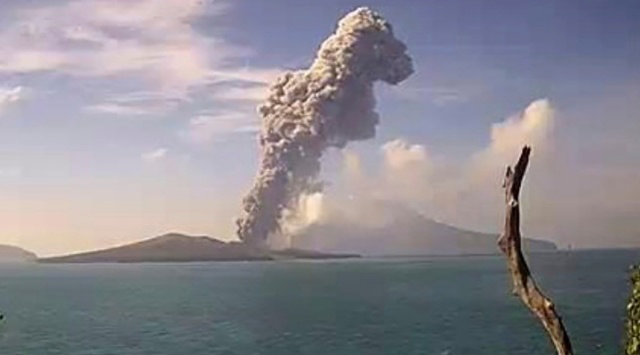Description

Disclaimer: Copyright infringement not intended.
Context: The eruption of Anak Krakatau volcano in Indonesia.
Details
- Anak Krakatau volcano, located in Indonesia's Sunda Strait, erupted several times since late Friday.
- The eruption sent ash as high as 3 kilometers into the air.
- It was the longest eruption since the volcano's explosive collapse in 2018, which triggered a deadly tsunami.
Impact and Safety Measures:
- No casualties were reported in the latest eruption, and there was no evacuation order issued.
- The nearest settlement is located 16 1/2 kilometers away from the volcano.
- Authorities had previously issued a warning for residents and tourists to stay 5 kilometers away from the crater.
Ongoing Alert Status:
- The volcano has remained on the second-highest alert level since 2018.
- The eruption serves as a reminder of the potential risks associated with the volcano.
Changes in Anak Krakatau Island:
- Scientists at Indonesia's Volcanology and Geological Hazard Mitigation Center reported that Anak Krakatau island is now only about a quarter of its original size compared to before the 2018 eruption.
- The peak of the crater now stands at 159 meters, reduced from its previous height of 338 meters.
Historical Context:
- Anak Krakatau is the offspring of the famous Krakatau volcano, which had a monumental eruption in 1883, leading to a global cooling period.
- A 2019 study conducted by the center highlighted the destructive power of the tsunami caused by the 2018 collapse, resulting in over 430 deaths and the displacement of 40,000 individuals.

About Volcanoes of Indonesia
- Indonesia is located in the Pacific Ring of Fire, a region known for its intense seismic and volcanic activity.
- The country has more active volcanoes than any other nation, with over 130 active volcanoes and numerous dormant ones.
- Indonesia's volcanic landscape is a result of its location at the meeting point of several tectonic plates, including the Eurasian, Pacific, Australian, and Philippine Sea plates.
Types of Volcanoes:
- Indonesia has a diverse range of volcanoes, including stratovolcanoes, shield volcanoes, and calderas.
- Stratovolcanoes: These are steep-sided conical volcanoes built up by alternating layers of lava and ash. They are the most common type in Indonesia.
- Shield Volcanoes: These volcanoes have a broad, shield-like shape and are formed by the accumulation of fluid lava flows.
- Calderas: Calderas are large, basin-shaped depressions that form when a volcano collapses following a massive eruption.
Active Volcanoes:
- Mount Merapi: Located in Central Java, it is one of the most active and dangerous volcanoes in Indonesia. It has had numerous eruptions throughout history.
- Mount Agung: Located in Bali, it is considered sacred by the Balinese people. It had a significant eruption in 2017, leading to the evacuation of thousands of people.
- Mount Bromo: Situated in East Java, it is a popular tourist destination known for its dramatic landscapes and stunning sunrise views.
- Mount Rinjani: Located on Lombok Island, it is the second-highest volcano in Indonesia and is famous for its picturesque crater lake, Segara Anak.
Volcanic Hazards:
- Volcanic eruptions in Indonesia can pose significant hazards, including pyroclastic flows, ashfall, lahars (volcanic mudflows), and volcanic gases.
- These hazards can cause damage to infrastructure, disrupt air travel, impact agriculture, and pose risks to human health and safety.
- Indonesian authorities closely monitor volcanic activity and issue warnings and evacuation orders when necessary to mitigate the risks.
Volcanic Tourism:
- Indonesia's volcanic landscapes attract tourists from around the world who are interested in witnessing the power and beauty of these natural wonders.
- Popular activities include hiking, trekking, and visiting volcanic craters and hot springs.
- Local communities often benefit from tourism, which provides income opportunities and supports the preservation of cultural heritage.
Scientific Research and Monitoring:
- Indonesia's high volcanic activity provides a unique opportunity for scientific research and monitoring of volcanic processes.
- Volcanic observatories and research institutions collaborate to monitor volcano behavior, assess risks, and improve eruption forecasting and early warning systems.
- International partnerships support the exchange of knowledge and expertise to enhance volcano research and hazard mitigation efforts.
|
PRACTICE QUESTION
Q) Which type of volcano is most likely to produce an explosive eruption?
A. Shield volcano
B. Cinder cone volcano
C. Stratovolcano
D. Caldera volcano
Answer: B
|

https://indianexpress.com/article/world/indonesia-anak-krakatau-volcano-eruption-8655907/
















